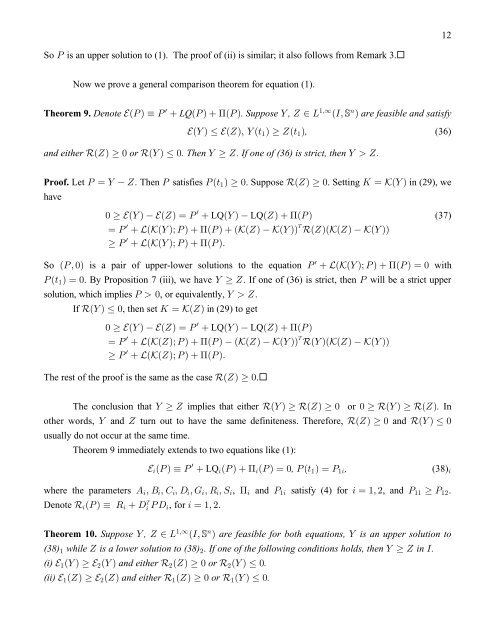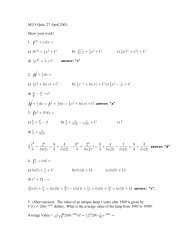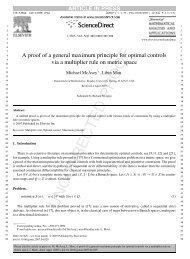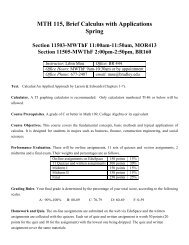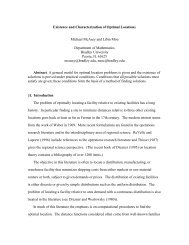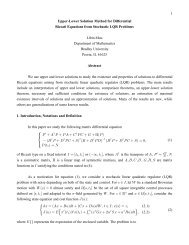1 Upper-Lower Solution Method for Differential Riccati Equations ...
1 Upper-Lower Solution Method for Differential Riccati Equations ...
1 Upper-Lower Solution Method for Differential Riccati Equations ...
Create successful ePaper yourself
Turn your PDF publications into a flip-book with our unique Google optimized e-Paper software.
12<br />
So T is an upper solution to (1). The proof of (ii) is similar; it also follows from Remark 3. ¨<br />
Now we prove a general comparison theorem <strong>for</strong> equation (1).<br />
Theorem 9. Denote XaT b ´ T w € LQ aTb€ CaTb. Suppose ], ^ P "ß_ aMß’ 8 b are feasible and satisfy<br />
Xa] b Ÿ Xa^ bß<br />
] a> " b ^> a " b, (36)<br />
and either ea^ b ! or ea] b Ÿ!. Then ] ^ . If one of (36) is strict, then ] ž ^.<br />
Proof. Let Tœ ] ^ . Then T satisfies T a> " b !. Suppose ea^ b !. Setting Oœ^a]<br />
b in (29), we<br />
have<br />
w<br />
! Xa] b Xa^ b œ T € LQa] b LQa^b€ CaTb<br />
w<br />
œT € _^ a a] bàT b€<br />
CaT b€<br />
a^a^b X<br />
^a] bb ea^ba^a^b<br />
^a]<br />
bb<br />
w<br />
T € _^ a a]<br />
bàT b€<br />
CaTbÞ<br />
(37)<br />
So aTß! b is a pair of upper-lower solutions to the equation T w € _^ a a] bàT b€CaTb<br />
œ! with<br />
T a> " b œ! . By Proposition 7 (iii), we have ] ^. If one of (36) is strict, then T will be a strict upper<br />
solution, which implies Tž! , or equivalently, ]ž^.<br />
If ea] b Ÿ! , then set Oœ ^a^ bin<br />
(29) to get<br />
w<br />
! Xa] b Xa^ b œ T € LQa] b LQa^b€ CaTb<br />
w<br />
œT € _^ a a^ bàT b€<br />
CaTb<br />
a^a^ b<br />
X<br />
^a] bb ea] ba^a^b<br />
^a]<br />
bb<br />
w<br />
T € _^ a a^bàT b€<br />
CaTbÞ<br />
The rest of the proof is the same as the case ea^ b !¨ .<br />
The conclusion that ] ^ implies that either ea] b ea^ b ! or ! ea] b ea^b.<br />
In<br />
other words, ] and ^ turn out to have the same definiteness. There<strong>for</strong>e, ea^ b ! and ea]<br />
b Ÿ!<br />
usually do not occur at the same time.<br />
Theorem 9 immediately extends to two equations like (1):<br />
w<br />
X 3 aT b ´T € LQ 3 aTb€ aTb œ! , T a> b œT , (38)<br />
C 3 " "3<br />
where the parameters EßFßGßHßK<br />
ßVßW , C and T satisfy (4) <strong>for</strong> 3œ"ß# , and T T .<br />
X<br />
Denote e 3 aT b ´ V 3 €HTH 3 , <strong>for</strong> 3œ"ß#Þ<br />
3 3 3 3 3 3 3 3 "3 "" "#<br />
3<br />
Theorem 10. Suppose ], ^ P "ß_ aMß ’ 8 b are feasible <strong>for</strong> both equations, ] is an upper solution to<br />
(38)" while ^ is a lower solution to (38)#. If one of the following conditions holds, then ] ^ in M.<br />
(i) X a] b X a] b and either e a^ b ! or e a]<br />
b Ÿ! .<br />
" # # #<br />
(ii) X a^b X a^ b and either e a^ b ! or e a]<br />
b Ÿ! .<br />
" # " "<br />
3


